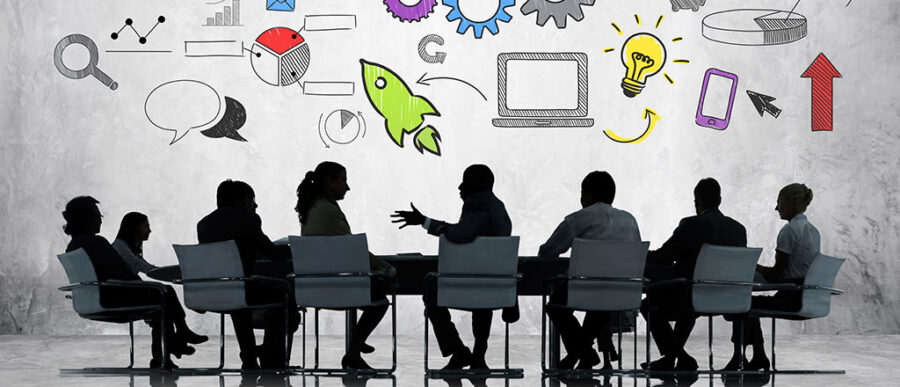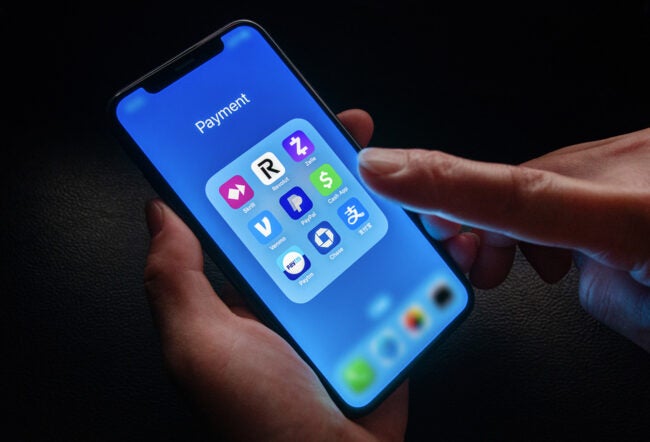The digital transformation of a company requires not a mere shuffling of the organizational chart, but rather a “chemical” change in the culture and business practices, says Ganesh Ayyar, CEO of Mphasis, a major IT services company. But it is easy to say and more difficult to do. One place to start is by encouraging experimentation through the celebration of failures, adds Wharton marketing professor Jerry (Yoram) Wind. Another is to learn to co-create with clients. As always, the CEO and other senior executives set the tone: The old command-and-control style of managing is becoming passe, replaced with a more collaborative model recognizing that good ideas can come from anywhere in the company.
Knowledge at Wharton recently spoke with Ayyar and Wind about the intricacies of company-wide digital transformation. What follows is an edited version of that conversation.
Knowledge at Wharton: Thank you both for joining us in this discussion about how CEOs and other top leaders can nurture a digital culture in their organization. As leaders, CEOs in particular, become more digitally transformed themselves, how do you move this down the organization?
Ganesh Ayyar: The physical transformation is an easier bit because you can draw up a new chart with new reporting lines, a new incentive scheme. The challenge lies in the chemical transformation of the company. How do you rewire the people? How do you equip them with new skill sets which are required in the new [digital age]? How do you actually walk the talk, because [risks arise;] when a company that is an analog business also aspires to get into the digital business, cannibalization is inevitable.
As a CEO, do you do something different while saying something different — in which case the authenticity of leadership becomes important? In my company, the mantra we have adopted is, “make customers central to our transformation.” Revolve around your customer strategy to be successful. So one of the things we have started measuring is this: Are we becoming more relevant to our customers? Everybody talks about the fact that this customer is relevant to me. Is that important from a business perspective? What is more important is — are you relevant to the customer? Because that gives you sustainability and longevity and it actually defines whether you are delivering value.
That is how we are keeping a customer-central theme to our transformation. We are focusing more and more on chemical transformation. Earlier, Jerry and I were discussing the idea of ‘where is our operational headquarters?’ One of the things that we are working on is making the trenches our headquarters. Where the customer is, you just go there and action around those things. Those are the elements that we are working on for our transformation. And you need to be ruthless with corporate antibodies [anything that serves as roadblocks to change]. In any transformation, you face corporate antibodies. One needs to be ruthless about [excising them].
“The challenge lies in the chemical transformation of the company. How do you rewire the people?”–– Ganesh Ayyar
Jerry (Yoram) Wind: It is absolutely critical that leaders understand the digital world and practice [operating in] it. But it is not enough. That is a necessary but not a sufficient condition. The sufficient condition is to move to the next step and say, “what are the implications to our mental models, what are the implications to our business models?” And basically, being willing to make the tough decisions, and have the courage to make the tough decisions … to face the new reality of the digital world.
We finished a study … that basically shows that there are four types of business models. There are asset builders, there are service providers, there are technology makers and there are network orchestrators. Network orchestrators will be the Uber, the Airbnb, Visa and MasterCard. The market value on these four business models vary dramatically. If you look at the market value as a multiple of revenue, you will find out that for … asset builders it is one to two, for service providers, two to three, technology makers about four. If you are a network company, it is about eight-plus.
To become a network company [and reap its] enormous benefits — there are zero marginal costs with an ability to scale infinitely and the like — you need a different type of mindset. As the leader, you have to change your mental model, you have to change the business model and move more towards the network, and you have to start realizing that it is no longer the command and control type of leadership. You basically have to become much more of a co-creator. And we look at the leadership required for a network orchestrator to be a co-creator of customers and others.
Think about what Apple has done with its ecosystem. There is no way they could have had the hundreds of thousands of apps out there [by making it] internally.… You have to have a culture of win-win and be willing to share with the customer. I will take it one step further and talk about your comment on the customer — it is not only how important you are to the customers, but treating the relationship [as co-creators].… How do we co-create together? What is the role of the customer in co-creating?
If you really move to co-creation and everyone’s organizations start getting into the culture of co-creation and it is a truly win-win, then you are on the way to winning in this transformation.
“You want to celebrate lessons from failure.” –– Jerry (Yoram) Wind
Ayyar: That’s an absolutely a brilliant point. I am glad you mentioned it. We set up a lab called Next Labs, because at Mphasis — the slogan is “Unleash the Next” — so we thought Next Labs would be a good name for our labs. The fundamental principle of that lab is one of [fostering] co-creation. If you are creating something on your own, that is less acceptable to us as an investment. It is more acceptable to us when you are co-creating it with the customer. We are willing to make more investments in that area than, say, if you have one bright idea and I am going to try it out.
Knowledge at Wharton: How does leadership, starting with the CEO, embrace this idea of being more collaborative? This is an egalitarian environment where you get immediate customer feedback … and you have to respond fast. How do corporate cultures change to accommodate that?
Ayyar: It is quite a thought-provoking question. It goes back to the fact that you have to come to terms with the fact that the CEO does not have a monopoly on all the great ideas. In fact, probably, he is the worst person to have great ideas. And a new person – it may be a youngster who has just joined the company — might have a great idea.
[Also,] you need to move from being a large boat or a large ship to a thousand canoes where employees are … empowered to make choices. And that change is not easy — although these concepts are easy to describe. We are in the midst of trying to do it. Even when you go to someone and say, “you are empowered to make the decision” — they have been demanding that empowerment — the moment that you give it, they are at a loss as to how to use it. They go back to the old habit of saying, “let me check with my boss before I make a decision.” So these concepts will take time to be ingrained in the company.
One needs to be patient.… You have to stay with it. I need to get comfortable with it too, because in my last 30 years, there are lots of things that are within my muscle memory [on managing] based on command and control, hierarchy, the ego of being a CEO, the glamour of being a CEO. You have to be prepared to take the shine off of yourself and reach out to people who can bring in these ideas. So those are all the cultural changes, authority changes, model changes that we are making. We are also making incentive changes. We are redefining the incentive as if we have multiple CEOs in the company, so it becomes a self-governing, motivated team.
I would not say that we have reached the destination or we have arrived. We have made progress, but we have still some ways to go.
“You need to move from being a large boat or a large ship to a thousand canoes where employees are … empowered to make choices.” –– Ganesh Ayyar
Knowledge at Wharton: What is your advice to companies on how they should change their culture? It is one thing to say it, another thing to live it.
Wind: First of all, congratulations [to Mphasis] on what you are doing, that is absolutely the right track. There are a lot of things we can talk about but I will give you two things — one, a change in the mental model, and the other is something very practical that every company should do.
The change in the mental model is in the concept of control. Most companies believe that they have control. Let us take, for example, the positioning of the brand. The reality is that the position of a brand is determined by the consumers, not by the company. So as long as you as a company, as a leader, believe that “I have control, I decide on the positioning,” [you do not have the full picture.] You, in reality, have zero control.
If you change the mental model to a collaborative, co-creating model, you realize from day one that control is shared between you and the customer.… The change to a co-creation model is absolutely critical here.
In terms of pragmatics, of how do we make it happen, I am a great believer in experimentation. If a company will adopt experimentation, they will be able to achieve a lot of things. The advantage of experimentation is this: It is the only way of determining a causal relationship; it is the only way in which you can actually measure and know exactly what is happening and what is the result of whatever you are doing.
The most important thing is that it encourages you to take more of an innovative initiative as opposed to just a “me too” [mentality]. And the minute you adopt the philosophy of experimentation through the company, you — as the CEO — send a message to the company that “it is okay to fail,” because everyone knows not every experiment will succeed. The minute you send the message, “it is okay to fail,” you are overcoming the natural inclination to be risk-averse.… Then you have to link it [to the] incentive and reward system, so you want to celebrate lessons from failure.
You will not be celebrating only successes, but what have we learned from something that did not work? … [Then] we move to experiment two, experiment three, four. This culture of experimentation is the new mental model for running a business, which is ideal for a distributed type of organization because they are not centralizing it. The only centralization that you want to do is, perhaps, in terms of creating meta-analysis of the many experiments.
“If you work … together as a co-creator with the customer, you will truly understand the needs of the customer.” –– Jerry (Yoram) Wind
Knowledge at Wharton: I wanted to dig into the customer-centricity idea a little bit because it makes sense — put the customer at the center and you will be okay. But what does customer centricity look like in a company? How do you nurture it? How do you encourage it and what does it mean? Do you have to understand exactly what they are thinking?
Ayyar: In our case, when you look back at offshore players, we were focusing on IT services, which meant you were calling on the chief information officer and the procurement site a majority of the time. As the world transforms to digital, the decision around digital will get made in the business side of things. So if you want to be relevant in the context of customer centricity in the digital world, you need to spend time understanding the customers’ customer and not just the customer. That’s the journey we have been tracking for the past 18 months as a company.
But we will have some cultural challenges.… By nature, people do not ask questions. They do not challenge. So you have to ensure that people challenge, people add value, they ask questions, because it is not just doing what they ask you to do, it is also about bringing the best practices based on your knowledge and experience and it is challenging the status quo. It is not just about serving what they want, but focusing on what they need. And that distance is truly the distance that we are trying to cover.
My transformation is linked to my customer’s transformation. And hence, I take responsibility for select customers. I saw some of the experiments in which they go to retail shops and the CEO serves there to understand the customer. I am not in that kind of B2C business. But I spend time in the trenches to understand what is going on, how can I add value? So the best way to define customer centricity is to understand the customers’ customer.
Wind: If you are in the B2B game, you cannot just limit yourself to the B2B space, you have to understand the B2C aspect. But let me give you three criteria that I will bring to customer centricity. One of them relates to the fact that you realize the customer is becoming now the active participant in the system. For example, in co-manufacturing, think about Build-a-Bear. The customer builds the product, not the factory.
Think about Facebook. Facebook provided a platform but all the content that Facebook has is created by customers. Think about Priceline.com. The customer decides what is the price. Think about distribution, why do I have to have sales people? Think about Diapers.com. Because of the incentives they provide for every customer to bring other customers and there are benefits for both of them, the customers became the salespeople for the company. So stop thinking about what you are doing as a company, but create a platform to allow your customers to do things. If you are doing this, you are way ahead in becoming customer-centric.
Second, realize the fact that if you work … together as a co-creator with the customer, you will truly understand the needs of the customer. When we talk about understanding the customer, the typical company will say, “okay, we will do market research.” Market research gives you, in most cases, almost wrong information, because first of all, you get tons of people who are not responding to this, if you are talking about [getting] a response fast.
Typically, you are also running structured Internet panels, which most people are not really responding to, and then these are structured questions as well. There are tons of problems with market research. While there are some good market research products and we have been using them, you will get far more reliable and valuable data if you get it through the interaction of co-creating with the customer.
Three, we should change the [metrics]. You should start thinking not about market share, but about share of wallet. What is my share of the total requirement of this customer? If you look at Mphasis, they should look at … what share they have of the total computing expenses of their client as a measure. Think about the lifetime value of a customer. Start thinking about different measures that focus on the customer, because most of the measures today are not customer-centric.



